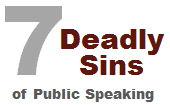

If you’ve experienced any of these, there’s a very good chance that the speaker failed to use appropriate speech transitions.
In this article, we define speech transitions and learn why they are so critical. In addition, we provide dozens of speech transition examples that you can incorporate into your speech.
Speech transitions are magical words and phrases that help your argument flow smoothly. They often consist of a single transition word or a short transition phrase, but occasionally form an entire sentence. In a written speech, speech transitions are generally found at the start of paragraphs.
Speech transitions smooth over the boundary between two ideas, and reveal the relationship between the words just spoken and those about to be spoken. In this way, speech transitions help your audience understand your message.
There are many types of speech transitions. Each type highlights a different verbal relationship. For example, one type of transition highlights the contrast between two different ideas.
Each of these types is itemized below. For each type, we list a few of the many possible words and phrases. Can you think of others?
“ Speech transitions smooth over the boundary between two ideas, and reveal the relationship between the words just spoken and those about to be spoken. ”
“ When executed well, speech transitions help make a speech understandable.
When executed poorly, speech transitions can obscure meaning and frustrate audiences. ”
For a short speech, you might conclude with a single statement:
In a longer presentation, your conclusion might include a review of a the key points:
In a team presentation, it is necessary to transfer control between speakers.
The abrupt way to do this is to simply have one person stop talking, and then have the other person start talking. It is much smoother, however, to pass the verbal baton to the next speaker (X):
There are many occasions when you need to jump back to an earlier idea to add additional information. e.g. after a break, following an exercise, or returning from an unplanned interruption
When executed well, speech transitions help make a speech understandable.
When executed poorly, speech transitions can obscure meaning and frustrate audiences.
Beware these four types of faulty transitions:
This is one of many public speaking articles featured on Six Minutes.
Subscribe to Six Minutes for free to receive future articles.

Andrew Dlugan is the editor and founder of Six Minutes. He teaches courses, leads seminars, coaches speakers, and strives to avoid Suicide by PowerPoint. He is an award-winning public speaker and speech evaluator. Andrew is a father and husband who resides in British Columbia, Canada.
Hi Andrew, how useful! I always see transitions like signposts point the audience in the direction that I want to go next, but some of these will be really useful at other times during a speech, thanks these will be a great resource. Recently, when speaking on a sensitive subject where I had pointed out a number of problems which the audience identified with i transitioned to the solution section by saying, “isn’t it good to know we are not the first people to have suffered with these issues and questions,” people were then expecting a move towards a solution phase and it worked well. I will keep these as a reference for the future, thanks!
Andrew Dlugan says:Indeed. Transitional words and phrases are minor signposts. I have a broader definition of signposts, however, which I plan to expand upon in a future article.
Excellent post, Andrew. I’ve definitely witnessed too many presentation with disjointed ideas and seemingly no connection to the subject matter, leaving me with that “What’s he talking about?” feeling. One additional thought about (#11) “Transitioning to Another Speaker” – which I often do in my workshops. Rather than announcing that you’re about to pass the mic to Speaker X, you can actually set them up for success using one of the other transition types. For instance:
(#7)- “We’ve now discussed a method for delivering effective feedback, let’s see it in action”… pass the mic.
(#9)- “We know we want our employees to be motivated, let’s explore some practical ways we can inspire our team to achieve greater levels of success”… pass the mic.
In each example, we’re handing the ball off (or throwing an Alley-oop pass) to Speaker X for a smoother (and less abrupt transition). It can be incredibly effective.
Good stuff!
It is so important to be consistent with the way one enumerates their points. For example, we don’t say first, then, finally but first, second, and third. That way the audience is not confused about when the speaker is near to completing his/her well organized speech. Excellent article!
Aiman Amrani says:Great guide Mr Dlugan. This is going to be very helpful for my comibg presentations this semester. Thank you.
Florangel says: Rene Guerra says:Dear Andrew, Thank you for this very useful succinct guide. Regarding tangential transitions, digressional matter –even if only contextually and even if vaguely related– can be inserted in the form of a diverticulum in the flow of text or speech, with the purposely intention of weaseling in something tangentially related, but of paramount importance to the writer or speaker. A “By the way,…” introduction to the diverticulum does smooth fairly well any abruptness in the transition. as it makes it illusively look or sound as appropriately parenthetical matter. And, when done with the digression, flow can be reinstated with a frank and explicit “Back on track,…” return-call transition. I have obtained miracles with the “By the way,…” and “Back on track,…” pair, even if talking about “oranges” and introducing an “apples” diverticulum…when what I actually had for sale was “apples “, not “oranges “. I know, it is a brazen “blow below the belt”, but in some particular instances, it is a pressing necessity which has to be, ineludibly, addressed.
Steven Tyson says: This helped me a lot with all of my transitions through my whole speech Sahan says: Thank you for this it really helped me. Haven says: Oh my goodness, Thank you so much! I really needed this for my speech! Ogwang Jacob Isaac says:Thanks so much for the most amazing experience i had missed it for a long time i am now able to make an exciting presentation. Thanks








Title Advanced Presentations by Design: Creating Communication that Drives Action Author Andrew Abela What is it About A comprehensive approach to planning and designing presentations focused on selling ideas and persuading your audience. Who Should Read It All presenters, particularly those who present in a business or scientific context. You will love this book if you like an interactive, workshop-style format. Book Review Read our book review

Title The Naked Presenter: Delivering Powerful Presentations With or Without Slides Author Garr Reynolds What is it About Packed with excellent advice, particularly on delivery skills and audience-centered presenting. Who Should Read It Everyone who wants to present more naturally and more effectively. Book Review Read our book review

Title Confessions of a Public Speaker Author Scott Berkun What is it About An irreverent insider's view of public speaking. You'll be both entertained and educated. Who Should Read It Any aspiring speaker who seeks honest insights about public speaking. Book Review Read our book review

Title Made to Stick: Why Some Ideas Survive and Others Die Author Chip Heath and Dan Heath What is it About Best-selling business book delivers on its promise to show how to communicate your ideas so that they will be remembered. Who Should Read It All speakers with a message that they want the audience to remember. In short, everyone. Book Review Read our book review

Title Presentation Patterns: Techniques for Crafting Better Presentations Author Neal Ford, Matthew McCullough, Nathaniel Schutta What is it About Covers presentation design and delivery with a focus on slide design. Organized according to patterns (i.e. building blocks), both positive and negative, which confront speakers. Who Should Read It All speakers will learn, but the pattern format will resonate particularly for technical speakers. Book Review Read our book review

Title Back of the Napkin: Solving Problems and Selling Ideas with Pictures Author Dan Roam What is it About Insightful and essential lessons for all communicators. Everyone can benefit by improving their visual thinking skills with the help of this book. Who Should Read It Smart people who want to improve their visual thinking skills. Book Review Read our book review